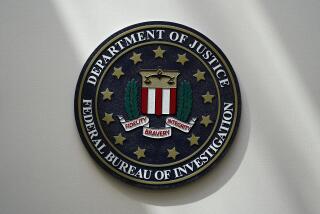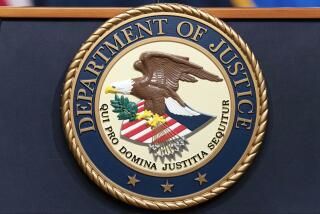Guilty Plea in Terrorist Plot
- Share via
WASHINGTON — An Ohio truck driver has pleaded guilty to conspiracy in connection with helping the Al Qaeda network scout targets for a possible second wave of terrorist attacks on New York and Washington after Sept. 11, federal prosecutors said Thursday.
The plot, including plans to sever the suspension cables of the Brooklyn Bridge, failed because the conspirators ultimately realized they couldn’t pull it off, the government said.
But the Justice Department described the arrest and conviction of Iyman Faris, 34, a Kashmiri-born naturalized American citizen, as a significant advance in its anti-terrorism war.
The government’s case, according to court papers that until Thursday were under seal in U.S. District Court in Alexandria, Va., detail how the Columbus, Ohio, truck driver became an active and willing foot soldier for Al Qaeda and its top leadership, from late 2000 through March of this year.
Faris pleaded guilty to two counts of violating a federal statute against providing material support to terrorist groups.
In his plea agreement, Faris admitted casing a New York City bridge -- not identified by name in court papers but which law enforcement officials said was the Brooklyn Bridge -- and doing Internet research into cable cutters, train-derailment equipment and other tools for possible attacks on U.S. targets.
He faces up to 20 years in prison, and a fine of up to $500,000 at sentencing, which is set for Aug. 1.
“On any given day, Iyman Faris appeared to be a hard-working independent truck driver. Working out of Columbus, Ohio, he freely crisscrossed the country making deliveries to airports and businesses without raising a suspicion,” Atty. Gen. John Ashcroft said at a news conference. “But Faris led a secret double life.”
With the arrest, Ashcroft added, “We have taken another American-based Al Qaeda operative off the streets,” alluding to convictions the government has already obtained of alleged Al Qaeda sympathizers in Detroit, Seattle and Buffalo, N.Y.
Ashcroft said the government took the unusual step of requesting that the plea agreement be kept under court seal for “a variety of national security reasons.” He indicated that the government was examining and exhausting other leads in the case and did not want to signal that to the public or to the suspects.
The plea agreement requires that Faris cooperate with prosecutors. At the news conference, the FBI’s top counter-terrorism chief, Pasquale J. D’Amuro, said the “investigation in Ohio remains ongoing.”
Ashcroft declined to say how Faris became known to officials, when and where he was arrested, and where he is incarcerated. He also declined to elaborate on why the case was brought in Alexandria; the Virginia court and the federal court in New York City share authority over Al Qaeda-related probes.
But one federal law enforcement official said Faris was arrested in the early spring in Columbus and brought to Virginia for questioning. The court documents also indicate that Faris had dealings with Al Qaeda operations chief Khalid Shaikh Mohammed, who was arrested in Pakistan in March and has been cooperating with U.S. authorities.
Faris’ attorney, J. Frederick Sinclair of Alexandria, could not be reached for comment.
Faris, also known as Mohammed Rauf, according to court papers, entered the U.S. in May 1994 and became a U.S. citizen in December 1999. He was employed for several years as an independent truck driver.
In late 2000, he traveled with a longtime friend from Pakistan to Afghanistan, where he was introduced to Osama bin Laden at a terrorist training camp.
Faris and his friend had been close since the Soviet war with Afghanistan in the mid-1980s. The unnamed associate turned out to be a top Bin Laden associate -- his “right foot,” according to court papers.
While the friend’s identity could not be confirmed by government officials, some of the details of his activities appear to overlap with those of Tawfiq Attash Khallad -- an Al Qaeda leader believed to be the mastermind of the bombing of the U.S. destroyer Cole. Khallad was arrested in Pakistan in late April.
Faris soon began doing research at an Internet cafe in Karachi, studying ultralight airplanes -- the kind that Al Qaeda was looking to acquire as an “escape airplane,” court documents showed.
He accompanied his friend to a factory to order 2,000 sleeping bags for Al Qaeda troops and visited a travel agency to obtain airline tickets.
He bought the tickets under the guise of being a member of the Tablighi Jamaat -- an apolitical movement in Pakistan that stresses personal piety and that at one time counted the British rock musician formerly known as Cat Stevens among its members.
In early 2002, Faris was introduced to a person in Karachi described in court papers as the “number three man” in the Al Qaeda network and who sources said was Khalid Shaikh Mohammed. There, court documents said, Faris was told of Al Qaeda’s plans for a sequel to the Sept. 11 terrorist attacks.
The Al Qaeda leader expressed interest in Faris’ trucking background, especially deliveries he had made to airport cargo planes, which the documents said caught the leader’s interest because they would hold “more weight and more fuel.” The men talked about destroying a bridge in New York, and obtaining equipment needed for that operation -- acetylene “gas cutters” that they code-named “gas stations” in later conversations. The leader also explained that Al Qaeda was planning to derail trains and asked the new recruit to get tools for that too.
Returning to the United States from Pakistan in April 2002, Faris researched cable cutters and New York bridges on the Internet, and for advice searched out an acquaintance who had a technical background. In late 2002, according to the documents, he traveled to New York City to examine the bridge first-hand.
Ultimately, the plans fell through. He sent coded messages to his newfound allies indicating that he had been unsuccessful in obtaining the equipment.
He concluded, according to the court papers, “the plot to destroy the bridge by severing the cables was very unlikely to succeed because of the bridge’s security and structure.”
In a message sent early this year, court papers say he advised against going ahead with the bridge attack, using the code language “the weather is too hot.”
More to Read
Sign up for Essential California
The most important California stories and recommendations in your inbox every morning.
You may occasionally receive promotional content from the Los Angeles Times.










